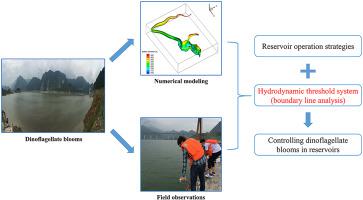Environmental Pollution ( IF 8.9 ) Pub Date : 2021-02-25 , DOI: 10.1016/j.envpol.2021.116822 Yang Song , Lian Shen , Linglei Zhang , Jia Li , Min Chen

|
Hydrodynamic conditions often affect the eutrophication process and play a key role in algal growth in reservoirs. A promising approach for controlling algal blooms in reservoirs is to create adverse hydrodynamic conditions by implementing reservoir operation strategies. However, research on this method is still nascent and does not support practical applications due to the lack of quantitative hydrodynamic thresholds. In this paper, field observations of algal growth from April 2015 to August 2016 were conducted, and a three-dimensional (3D) model that couples hydrodynamics and water temperatures for the Zipingpu Reservoir was established. Low flow velocities (V) and low Reynolds numbers (Re) in the Longchi tributary are favorable for dinoflagellate growth and accumulation, which can explain why dinoflagellate blooms are more likely to occur in the tributary. A temperature of 18–22 °C is considered a precondition for Peridiniopsis penardii blooms, suggesting that freshwater dinoflagellate species may prefer lower temperatures than marine dinoflagellate species. Shallow mixing layer depth (Zmix) is conducive to Peridiniopsis penardii gathering in the upper water layers and promotes growth. The shallow euphotic layer depth (Zeu) was speculated to promote the dominance of this species by stimulating its heterotrophy and inhibiting other algal autotrophy. Furthermore, a boundary line analysis was introduced to characterize the relationships between algal biomass and hydrodynamic indicators. Thus, the thresholds for V, Re, and Zmix/Zeu were determined to be 0.034 m s−1, 6.7 × 104, and 1.7, respectively. Either accelerating horizontal flow to exceed the thresholds of V and Re or facilitating vertical mixing to exceed the threshold of Zmix/Zeu can prevent dinoflagellate blooms. Therefore, the summarized hydrodynamic threshold system is suggested to be an effective standard for controlling dinoflagellate blooms in the reservoir. Moreover, this study can provide a useful reference for understanding the mechanism of freshwater dinoflagellate blooms.
中文翻译:

控制水库中鞭毛藻水华的水动力阈值系统研究
流体动力学条件通常会影响富营养化过程,并在水库中藻类的生长中起关键作用。控制储层藻华的一种有前途的方法是通过实施储层运行策略来创造不利的水动力条件。但是,由于缺乏定量的流体动力学阈值,对该方法的研究仍处于起步阶段,不支持实际应用。本文对2015年4月至2016年8月的藻类生长进行了现场观测,并建立了将紫坪铺水库水动力与水温耦合的三维(3D)模型。低流速(V)和低雷诺数(Re)在龙池支流中有利于鞭毛藻的生长和积累,这可以解释为什么在支流中更容易发生鞭毛藻的繁殖。18-22°C的温度被认为是槟榔泛盛的先决条件,这表明淡水鞭毛藻物种比海洋鞭毛藻物种更喜欢较低的温度。浅层混合层深度(Z mix)有利于Peridiniopsis penardii聚集在上层水层中并促进生长。浅层常绿层深度(Z eu)被认为通过刺激其异养和抑制其他藻类自养来促进该物种的优势。此外,引入边界线分析来表征藻类生物量与流体动力学指标之间的关系。因此,阈值V,再和ž混合/ Ž EU被确定为0.034米小号-1,6.7×10 4,和1.7,分别。加快水平流量以超过V和Re的阈值,或者促进垂直混合超过Z mix / Z eu的阈值可以防止鞭毛的花开。因此,建议将总结的水动力阈值系统作为控制储层中鞭毛藻繁殖的有效标准。此外,该研究可为理解淡水鞭毛藻开花的机理提供有用的参考。



























 京公网安备 11010802027423号
京公网安备 11010802027423号